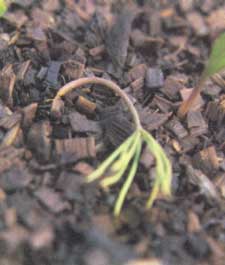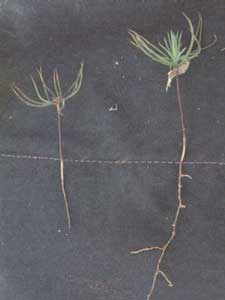Pythium Root RotArthur H. McCain - Plant Pathologist, Department of Plant Pathology, University of California, Berkley, CA, Cordell C.E., Anderson R.L., Hoffard W.H., Landis T.D., Smith R.S. Jr., Toko H.V., 1989. Forest Nursery Pests. USDA Forest Service, Agriculture Handbook No. 680, 184 pp. Hosts Pythium root rot, caused by Pythium spp. (especially P. aphanidermatum, P. debaryanum, and P. irregulare) affects all conifers and hardwoods, with the exception of willows and possibly alders. Distribution The disease occurs throughout the world. Pythium spp. exist in virtually all cultivated soils. Damage Attack by Pythium spp. can kill seedlings outright or render them unsalable through stunting and chlorosis. Diagnosis Pythium can infect most plant tissues, but juvenile or younger tissues near root tips are most susceptible. When recently emerged seedlings are infected, the fungus usually kills them outright, resulting in typical damping-off symptoms (fig. 44-1). Infections on older seedlings result in stunted and chlorotic plants. The roots on these plants turn brown or black; lateral and feeder roots are absent (fig. 44-2). When these roots are gently pulled, the cortex will slip off, leaving the stele. Damage caused by Pythium will be greater in lower, wetter areas of the nursery. Lightly infected seedlings usually recover as the soil dries, with the seedlings developing new roots first in the upper soil layers and elevated portions of seedbeds. Seedling samples suspected of being infected should be collected as soon as possible because secondary saprophytic fungi rapidly colonize plant tissues recently killed by Pythium. Diseased plant tissue can be cultured in the laboratory either on water agar at 68 oF, or on a selective medium. Pythium spp. are identified microscopically by their sexual spore states and sporangia. Biology Pythium spp. are soil-inhabiting fungi that survive as oospores, resistant sporangia, or chlamydospores when susceptible plant material is absent and when conditions are unfavorable. The resting spores are stimulated to germinate by the presence of water and root exudates. Germ tubes of these spores can penetrate roots of susceptible seedlings directly. Other propagules germinate to produce motile spores (zoospores), which spread in water and infect roots or other susceptible host tissue. Control Prevention - Avoid poorly drained fields with a history of Pythium infection. Do not overwater. Improve drainage. Cultural - Employ crop rotation with nonsusceptible hosts, such as small grains, to reduce the inoculum density. Chemical - Apply a soil fumigant before sowing, preferably methyl bromide - chloropicrin combination. Avoid using contaminated equipment, soil, or seedlings, so as not to reintroduce the fungi into fumigated tiursery seedbeds. Use soil fungicides, such as propamocarb hydrochloride, etridiazole, or metalaxyl as a drench to control the disease on established seedling crops. Selected References Baker, Kenneth F. 1957. The U.C. system for producing healthy container-grown plants. [Place of publication unknown]: University of California, Division of Agricultural Sciences. 332 p. Hepting, George H. 1971. Diseases of forest and shade trees of the United States. Agric. Handb. 386. Washington. DC: U.S. Department of Agriculture. 658 p. Waterhouse, Grace M. 1968. The genus Pythium Pringsheim. Mycol. Pap. 110. Kew, England: Commonwealth Mycological Institute. |
Forest Pests: Insects, Diseases & Other Damage Agents |

|
|



